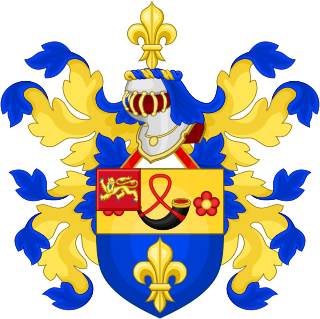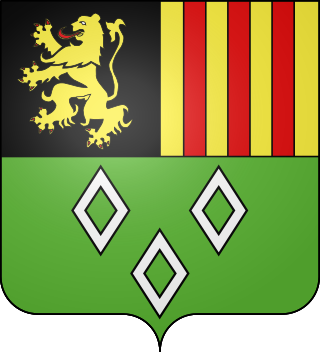Related Research Articles

The House of Hornes was an old and important European noble family, which became extinct in the male line in 1826. The name refers to Horn, a small village in Limburg, located in the Netherlands.

Charles Philippe Henri Jean Baptiste van de Werve (1706–1776), 1st count of Vorselaar, formed part of a very old, important and noble family of Antwerp.

The Collegiate Church of St. Gertrude is a Roman Catholic collegiate church in Nivelles, Walloon Brabant, Belgium, which was built in the 11th century. It is dedicated to Saint Gertude, the patron saint of cats.

The Van de Werve family is one of the oldest Belgian noble families from Antwerp that is still in existence.

Vilain and Vilain XIIII is a Belgian noble family. Their coat of arms is basically "Sable, on a chief argent a label of the field", a colour scheme that is present from the earliest Vilains in the 15th century, and is also seen in the Vilain XIIII arms, which have the "XIIII" added to it.
Van der Noot is a Dutch or Flemish surname, with several variations. Van der Noot may refer to:

The de Lalaingfamily is a noble family from the south of Flanders which played an important role in the history of the County of Hainaut and of the Netherlands. The current family belongs to the Belgian nobility.

The House of Lannoy is the name of an old and important Belgian noble family that takes its name from the town of Lannoy in northern France. The name comes from l'Annoy, which means 'the alderwood' in Picard French of Flanders.

Marquess of Assche is a title belonging to the Belgian nobility, Assche is the old writing of the city of Asse. The Margraveships still stands today and belongs to the House van der Noot. Today the current Marquess of Assche still resides in Belgium.

Philips Erard van der Noot (1638–1730) was the 13th Bishop of Ghent.

The Van der Noot family is a Belgian noble family. The title of Count van der Noot is a title created by Emperor Charles VI on 16 May 1716. Since then this title belongs to the Belgian nobility.
Marie Josepha Taye, Countess van der Noot and Marquise of Assche and Wemmel, was a noble lady from Flanders.

The Rubens family is a Flemish noble family that lived in Antwerp.

The House of Glymes was an old Belgian noble family, an illegitimate branch of the House of Reginarid, which ruled the Duchy of Brabant. Glymes or Glimes is a municipality of Incourt. Their descendants of the branch of Grimberghen are styled as the Prince de Grimberghen.

Brimeu is a noble family, some members belonging to the Flemish aristocracy. Brimeux, previously in Flanders, is now in France.
Jean Alphonse, 1st Count de Coloma, was a Flemish noble lord of Spanish descent, a member of the House of Coloma. He was a councillor on the Great Council of Mechelen and the supreme council in Vienna, and president of the Privy Council of the Habsburg Netherlands .

The Snoy family or Snoy d'Oppuers currently Snoy et d'Oppuers, is a Belgian noble family. The current descendants are titled Barons Snoy and of Oppuers.
The Lords of Saventhem and Sterrebeke, currently Zaventem and Sterrebeek, were two Heerlijkheden in Flanders. The lords of Zaventem resided in Ter Meeren Castle.
Lord Chamberlain of the Archduchess was a ceremonial function at the imperial court of Brussels.
References
- ↑ "Roger-Wauthier van der Noot, baron de Carloo et bourgmestre de Bruxelles". Hestroff, village de la Moselle francique. Retrieved Oct 17, 2020.
- ↑ "Lieux à voir". Archived from the original on 2017-12-10. Retrieved 2017-12-09.
- ↑ Nederlandsch Geslacht- Stam- en Wapen-Boek: waarin voorkomen de ..., Volume 2